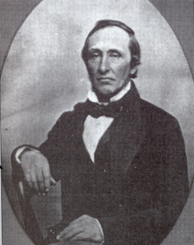Hugh Nixon Shaw
Hugh Nixon Shaw (1812-February 11, 1863) is an Irish-Canadian oil producer and businessman. Shaw is best known for being misidentified as the discoverer of the Shaw well, Canada's first oil gusher, on January 16, 1862.[1][2]
Hugh Nixon Shaw | |
|---|---|
 | |
| Born | 1812 |
| Died | February 11, 1863 Oil Springs, Ontario, Canada West |
| Cause of death | Asphyxiation |
| Occupation | Oil producer and businessman |
Biography
Hugh Nixon Shaw was born near Dublin, Ireland, in 1912.[3] At some point, Shaw emigrated to Canada West and operated a general store in Cooksville, before moving to Enniskillen Township sometime in the late 1850s or early 1860s.[3][4] Shaw became a successful oil producer, patenting a distilling process that made oil less volatile.[5][6] Shaw defined his process as applying heat and benzol to remove the impurities out of the oil.[5][6] Shaw operated a refinery until it burnt down in May 1862.[7]
On February 11th, 1863, Shaw died checking the status of one of his oil wells.[7][8] According to one of his employees, he asked two workers to lower him into his well to grab hold of a pipe that had gotten loose.[8] After fixing the pipe and calling out to be hauled back up, Shaw began coughing and fell backwards into the oil well.[8] An autopsy revealed that Shaw died of asphyxiation from the poisonous gases inside the well.[8]
Shaw Gusher Controversy
Contemporary Historians and journalists often miscredit Hugh Nixon Shaw as the discoverer of Canada's first oil gusher.[1][2] The real founder was John Shaw, another oil producer in Enniskillen Township.[1][2] The confusion over who struck the gusher appears to have arisen from historian Robert Harkness, who claimed in his 1940 publication Makers of Oil History: 1850-1880 that a series of articles in the Toronto Globe credited Hugh Nixon Shaw with the discovery.[1][2] In fact, the articles Harkness cited were written months before the gusher was struck, and only discuss Hugh Nixon Shaw's distillation process.[1] When the Globe began reporting on the gusher in January 1862, they identified the discoverer as a "Mr. Shaw, lately of Port Huron, Michigan, a daugerrean artist, and formerly of Kingston West," a description that fits John Shaw, not Hugh Nixon Shaw.[1][2] Moreover, on February 5, 1862, the Globe directly credited John Shaw as the discoverer of the well.[1] Despite Harkness' error, his research had a significant impact on other historians and journalists, who began citing Hugh Nixon Shaw as the discoverer of the Shaw gusher.[1][2]
References
- "What is True History? The Shaw Gusher Question". Lambton County Museums. Retrieved 2020-06-25.
- Gray, Earle. (2008). Ontario's petroleum legacy : the birth, evolution and challenges of a global industry. Edmonton: Heritage Community Foundation. p. 32. ISBN 978-1-4593-3970-5. OCLC 842999352.
- "Mr. Hugh Nixon Shaw, of Cooksville". Christian Guardian. May 27, 1863.
- Cronin, Fergus (April 1959). "Who Really Drilled the Great Shaw?" (PDF). Imperial Oil Review.
- MacEachern, Alan. (2019) An Environmental History of Oil Development in Southwestern Ontario, 1858-1885 (PhD Thesis). Western University. p. 66.
- "The Oil Springs of Enniskillen". Toronto Globe. March 13, 1862.
- Burr, Christina. (2006). Canada's Victorian Oil Town : the Transformation of Petrolia from Resource Town into a Victorian Community. Montreal, Kingston, London and Ithaca: McGill-Queen's University Press. p. 220. ISBN 978-0-7735-7590-5. OCLC 951204013.
- "From the Oil Springs". Toronto Globe. February 18, 1863.